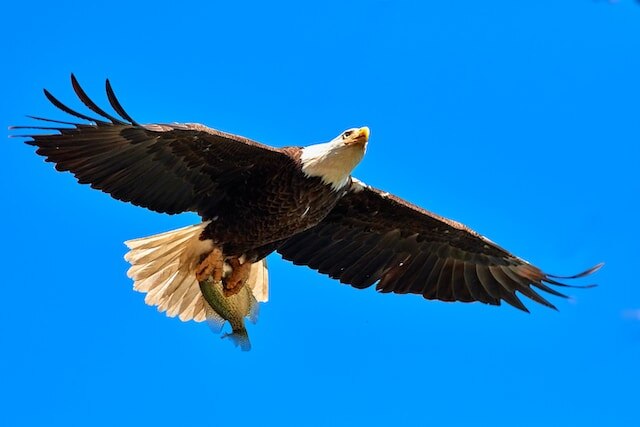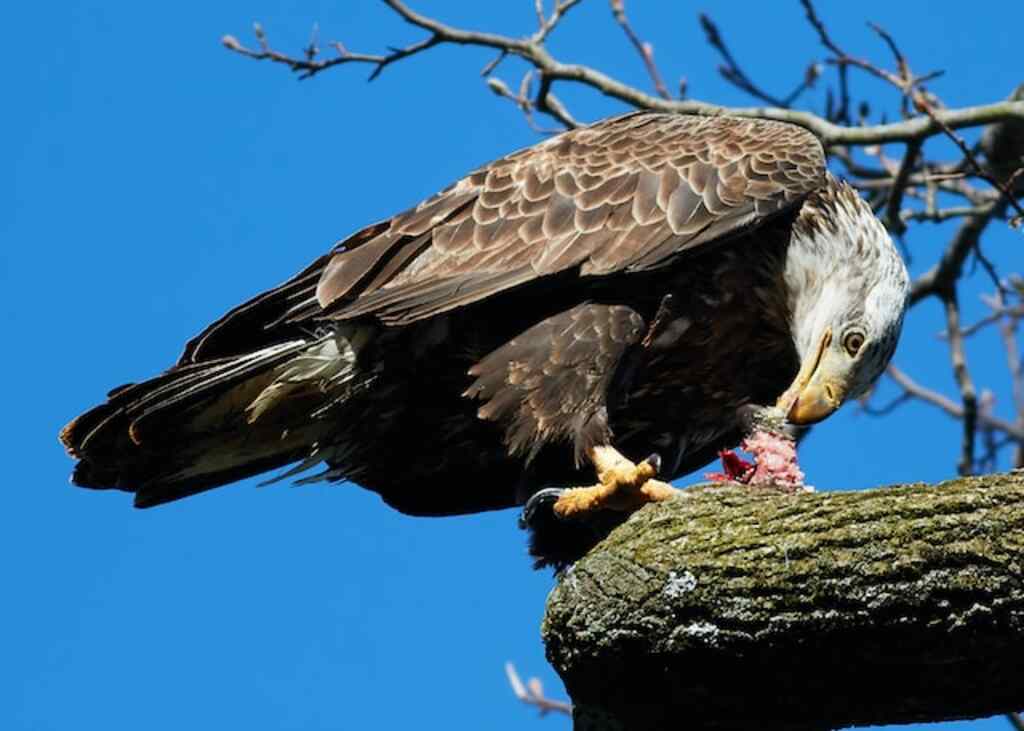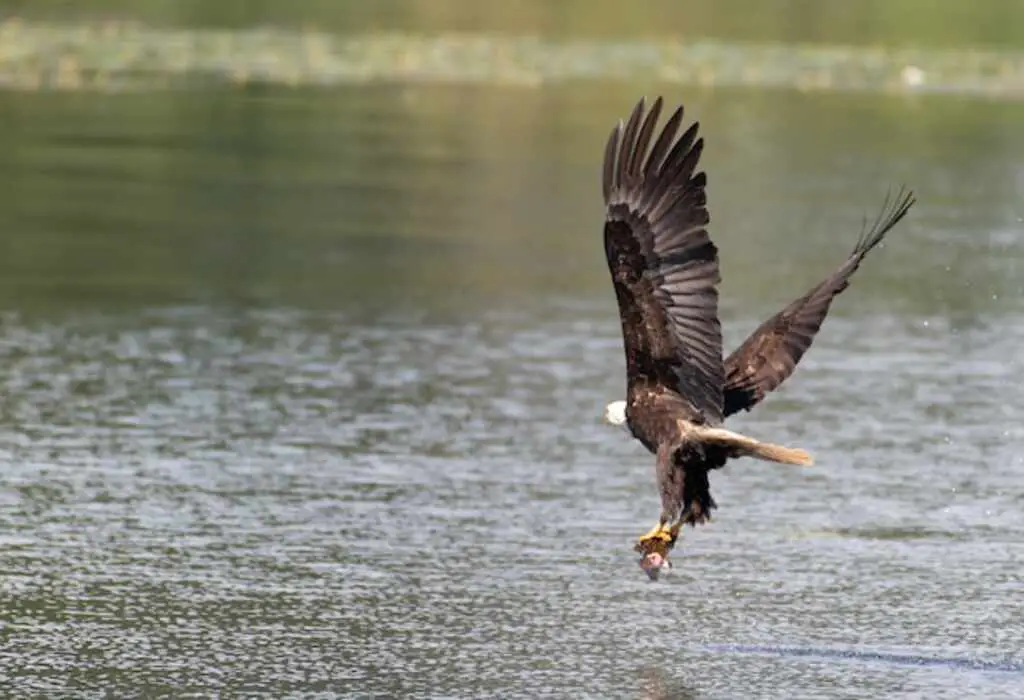According to recent studies, eagles are known for their impressive hunting abilities and their preference for fresh prey. However, there has been much debate surrounding the question, ‘Do eagles eat dead fish?’
It is estimated that over 70% of an eagle’s diet consists of live prey, such as fish, small mammals, and birds.
Nevertheless, eagles do occasionally scavenge for food, including dead fish. This scavenging behavior is believed to supplement their diet when live prey is scarce.
Eagles are equipped with sharp talons and a powerful beak, which enable them to catch and tear apart their prey.
Their hunting techniques involve soaring high in the sky, scanning the landscape, and diving at incredible speeds to snatch their prey from the water’s surface.
The ability to catch live prey is crucial for their survival, as it provides essential nutrients and energy. However, a varied diet, which includes dead fish, can also play a role in their overall health and well-being.
Understanding the feeding behavior of eagles, including their interaction with dead fish, is essential for wildlife conservation efforts and maintaining a harmonious coexistence with these magnificent birds.
Table of Contents
- 1 Key Takeaways
- 2 Do Eagles Eat Dead Fish
- 3 Eagle Diet and Feeding Habits
- 4 Reasons Behind Eagle’s Preference for Fresh Prey
- 5 Role of Scavenging in Eagle’s Diet
- 6 Eagle’s Hunting Techniques
- 7 Adaptations for Catching Live Prey
- 8 Importance of a Varied Diet for Eagles
- 9 Competition for Food Resources
- 10 Eagle’s Feeding Behavior in Different Environments
- 11 Human Interactions and Feeding Eagles
- 12 Frequently Asked Questions
- 12.1 Can eagles survive solely on a diet of dead fish?
- 12.2 Do eagles scavenge for food even when fresh prey is available?
- 12.3 How do eagles catch live prey?
- 12.4 What adaptations do eagles have for catching live prey?
- 12.5 How does a varied diet benefit eagles in terms of their overall health and survival?
- 13 Conclusion
- 14 Author
Key Takeaways
- Eagles primarily prefer live prey for their diet, with over 70% consisting of fish, small mammals, and birds.
- However, when live prey is scarce, eagles will scavenge for food, including dead fish.
- Scavenging behavior supplements their diet and provides a varied diet for overall health.
- Scavenging allows eagles to access food sources they can’t catch themselves and plays a significant role in their survival.
Do Eagles Eat Dead Fish
Yes, eagles do eat dead fish. While they are skilled hunters, they are opportunistic feeders and will consume carrion, including dead fish, if available. This behavior helps them find food more easily and ensures they get their daily sustenance.
Eagle Diet and Feeding Habits
The diet of eagles primarily consists of live fish, although they do occasionally scavenge on dead fish as well. Eagles prefer fresh prey due to several reasons.
Fresh fish provides higher nutritional value to eagles, as it contains essential nutrients such as proteins and omega-3 fatty acids.
Additionally, fresh prey reduces the risk of bacterial infections and ensures optimal health for the eagles. This preference for fresh prey will be further explored in the subsequent section.
Reasons Behind Eagle’s Preference for Fresh Prey
The preference of eagles for fresh prey can be attributed to several key factors.
Firstly, fresh prey offers higher nutritional value compared to dead or decaying prey. This is crucial for the eagle’s energy requirements and overall health.
Secondly, the preference for fresh prey is an instinctual behavior that has been developed over generations.
Eagles have evolved to recognize and target live prey, as it increases their chances of successful hunting.
Lastly, the preference for fresh prey can also be seen as a survival strategy.
By targeting live prey, eagles are able to avoid potential risks associated with consuming decaying or contaminated food, minimizing the chances of illness or infection.
Nutritional Value of Fresh Prey
Fresh prey provides the eagle with essential nutrients necessary for its survival and growth. The impact of pollution on prey quality can affect the nutritional value of fresh prey for eagles.
Additionally, the availability of prey can influence eagle populations.
The nutritional value of fresh prey plays a crucial role in the eagle’s ability to maintain its health and thrive.
Understanding this aspect of the eagle’s diet is essential for comprehending its instinctual behavior and survival strategy.
Instinctual Behavior and Survival Strategy
Innate instincts and strategic survival tactics are integral to the eagle’s ability to procure sustenance and thrive in its environment.
Their instinctual behavior and foraging techniques are honed through generations of evolution, allowing them to efficiently hunt for prey.
Eagles employ various strategies such as aerial hunting, perch hunting, and plunge diving to capture their prey, primarily fish.
These techniques demonstrate their adaptability and resourcefulness in ensuring a successful hunt.
Understanding their instinctual behavior and foraging techniques sheds light on the role of scavenging in the eagle’s diet.
Role of Scavenging in Eagle’s Diet
Scavenging plays a significant role in the dietary habits of eagles, as it provides them with the opportunity to consume dead fish.
This behavior is crucial for their survival, as it allows them to access food sources that they may not be able to catch themselves.
By scavenging, eagles can take advantage of the resources left behind by other predators or natural causes.
However, scavenging is just one aspect of the eagle’s diet, as they also employ various hunting techniques to secure their prey.
Eagle’s Hunting Techniques
With astonishing precision and lightning speed, eagles employ a diverse array of hunting techniques to capture their elusive prey, ensuring their survival through a calculated and strategic approach.
Their exceptional vision plays a crucial role in their hunting success, allowing them to spot prey from great distances.
Coupled with their incredible hunting accuracy, eagles are able to swiftly and efficiently snatch their prey from the air or water.
These hunting techniques are just one aspect of their remarkable adaptations for catching live prey.
Adaptations for Catching Live Prey
Adapted to their environment, eagles possess a range of specialized characteristics and techniques for capturing live prey. These hunting adaptations include:
- Exceptional Eyesight: Eagles have keen eyesight, enabling them to spot prey from great distances.
- Powerful Talons: Their strong and sharp talons allow eagles to grasp and immobilize their prey.
- Swift Flight: Eagles can swoop down on their prey with incredible speed and agility.
- Diving Techniques: They employ diving strategies to surprise and capture their prey underwater.
Understanding the hunting strategies of eagles highlights the importance of a varied diet for their survival.
Importance of a Varied Diet for Eagles
A diverse diet is crucial for the survival of eagles as it ensures they receive the necessary nutrients and energy to thrive in their environment.
Variety benefits eagles by providing a range of nutrients and reducing the risk of dietary deficiencies. Eagles have specific dietary needs that can only be met through a varied diet.
By consuming a variety of prey species, eagles can obtain the essential proteins, fats, vitamins, and minerals they require.
This diverse diet enables eagles to maintain their fitness and adaptability in their habitat. The next section will discuss the competition for food resources among eagles.
Competition for Food Resources
Competition for food resources is a significant aspect of the eagle’s diet and survival. Interactions with other predators play a crucial role in determining the availability of prey for the eagles.
For example, competition with other avian predators, such as owls and hawks, can lead to a decrease in the availability of prey for eagles.
Additionally, the relationship with scavengers, such as vultures and crows, can also impact the availability of food resources for eagles, as scavengers may consume carcasses that eagles rely on for sustenance.
Interactions with Other Predators
Interactions between eagles and other predators, such as wolves and bears, often result in competition for limited food resources.
Eagles also have interactions with aquatic predators, which can impact fish populations. As eagles feed on dead fish, they may compete with other predators for this food source.
Additionally, eagles’ presence may influence the behavior and distribution of aquatic predators.
These interactions highlight the complex dynamics of predator-prey relationships in ecosystems. In the next section, we will explore the eagles’ relationship with scavengers.
Relationship with Scavengers
Scavengers play a crucial role in the ecosystem by facilitating the decomposition process and recycling nutrients, and their relationship with eagles is an essential aspect of this intricate web of ecological interactions.
In the realm of eagle scavenging habits, competition with other scavengers arises. Vultures, crows, and ravens are often observed engaging in aerial battles with eagles over carcasses.
This fierce competition highlights the importance of scavengers in the ecosystem.
Transitioning to the next section, understanding the eagle’s feeding behavior in different environments provides further insights into their ecological role.
Eagle’s Feeding Behavior in Different Environments
In diverse environments, eagles demonstrate their feeding behavior by effortlessly swooping down to snatch dead fish from the water’s surface.
In urban areas, eagles have adapted to scavenge for food, including dead fish, in garbage dumps and landfills.
However, climate change poses a threat to the eagle’s food sources, as it affects the availability and distribution of fish populations.
Understanding the impact of these changes on the eagle’s feeding behavior is crucial for effective conservation strategies.
Moving forward to human interactions and feeding eagles, it is important to consider the potential consequences of such actions.
Human Interactions and Feeding Eagles
Human-provided food sources can significantly impact the ecological dynamics and behaviors of eagles. This interaction between humans and eagles, although seemingly harmless, can have ethical implications.
The human-animal bond created through feeding eagles can lead to dependency and altered foraging behaviors.
Additionally, providing food to eagles disrupts the natural food chain and can result in negative consequences for other species.
It is essential to consider the potential long-term effects of human interactions on eagle populations and their ecosystems.
Frequently Asked Questions
Can eagles survive solely on a diet of dead fish?
Eagles do scavenge dead fish, however, relying solely on a diet of dead fish may not provide sufficient nutritional value. It is essential for eagles to have a diverse diet to ensure their survival.
Do eagles scavenge for food even when fresh prey is available?
Eagle scavenging behavior is observed even when fresh prey is available. This behavior may have implications for eagle population dynamics. The impact of scavenging on eagle populations deserves further investigation to better understand its role in their survival and reproduction.
How do eagles catch live prey?
Eagle hunting techniques involve a combination of agility, speed, and keen eyesight. They employ various strategies like swooping down from great heights or ambushing their prey. Prey selection patterns are based on factors like size, availability, and vulnerability.
What adaptations do eagles have for catching live prey?
Eagles have evolved hunting techniques and talon adaptations to effectively catch live prey. These adaptations include sharp and curved talons, strong grip strength, and keen eyesight, allowing them to spot, pursue, and capture their prey with precision and efficiency.
How does a varied diet benefit eagles in terms of their overall health and survival?
Diet diversity is crucial for eagles as it helps meet their nutritional requirements. Having a varied diet ensures that eagles receive all the essential nutrients, vitamins, and minerals necessary for their overall health and survival.
Conclusion
In conclusion, the eagle’s diet and feeding habits revolve around its preference for fresh prey. While scavenging plays a role in its diet, the eagle primarily relies on its hunting techniques and adaptations to catch live prey.
A varied diet is crucial for the eagle’s survival, but competition for food resources can pose challenges. The eagle’s feeding behavior varies in different environments, and human interactions can impact its feeding habits.
Through the juxtaposition of these factors, a vivid image of the eagle’s complex relationship with food emerges.







